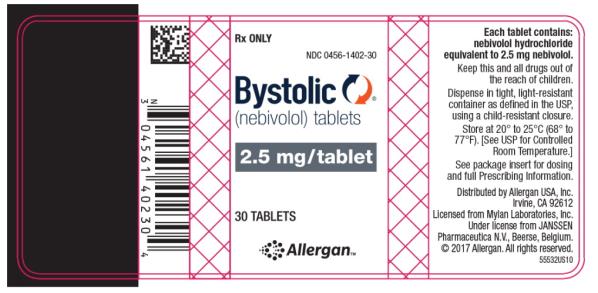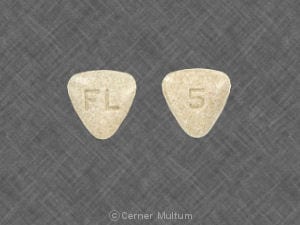Bystolic
Generic name: nebivolol
Drug class: Cardioselective beta blockers
Medically reviewed by A Ras MD.
What is Bystolic?
Bystolic is a kind of prescription medicine called a “beta-blocker”. Bystolic treats High blood pressure (hypertension). Bystolic can lower blood pressure when used by itself and with other medicines.
Bystolic is not approved for children less than 18 years of age.
What is high blood pressure (hypertension)?
Blood pressure is the force in your blood vessels when your heart beats and when your heart rests. You have high blood pressure when the force is too great.
High blood pressure makes the heart work harder to pump blood through the body and causes damage to the blood vessels. Bystolic tablets can help your blood vessels relax so your blood pressure is lower. Medicines that lower your blood pressure lower your chance of having a stroke or heart attack.
Description
The chemical name for the active ingredient in BYSTOLIC (nebivolol) tablets is (1RS,1’RS)-1,1’-[(2RS,2’SR)-bis(6-fluoro-3,4-dihydro-2H-1-benzopyran-2-yl)]- 2,2’-iminodiethanol hydrochloride. Nebivolol is a racemate composed of d-Nebivolol and l-Nebivolol with the stereochemical designations of [SRRR]-nebivolol and [RSSS]-nebivolol, respectively. Nebivolol’s molecular formula is (C22H25F2NO4•HCl) with the following structural formula:

SRRR – or d-nebivolol hydrochloride

RSSS – or l-nebivolol hydrochloride
MW: 441.90 g/mol
Nebivolol hydrochloride is a white to almost white powder that is soluble in methanol, dimethylsulfoxide, and N,N-dimethylformamide, sparingly soluble in ethanol, propylene glycol, and polyethylene glycol, and very slightly soluble in hexane, dichloromethane, and methylbenzene.
BYSTOLIC as tablets for oral administration contains nebivolol hydrochloride equivalent to 2.5, 5, 10, and 20 mg of nebivolol base. In addition, BYSTOLIC contains the following inactive ingredients: colloidal silicon dioxide, croscarmellose sodium, D&C Red #27 Lake, FD&C Blue #2 Lake, FD&C Yellow #6 Lake, hypromellose, lactose monohydrate, magnesium stearate, microcrystalline cellulose, pregelatinized starch, polysorbate 80, and sodium lauryl sulfate.
Mechanism of Action
The mechanism of action of the antihypertensive response of BYSTOLIC has not been definitively established. Possible factors that may be involved include: (1) decreased heart rate, (2) decreased myocardial contractility, (3) diminution of tonic sympathetic outflow to the periphery from cerebral vasomotor centers, (4) suppression of renin activity and (5) vasodilation and decreased peripheral vascular resistance.
Who should not take Bystolic?
Do not take Bystolic if you:
- Have heart failure and are in the ICU or need medicines to keep up your blood circulation
- Have a slow heartbeat or your heart skips beats (irregular heartbeat)
- Have severe liver damage
- Are allergic to any ingredient in Bystolic. The active ingredient is nebivolol. See “What are the ingredients in Bystolic?” fo a list of ingredients.
What should I tell my healthcare provider before taking Bystolic?
Tell your doctor about all of your medical problems, including if you:
- Have asthma or other lung problems (such as bronchitis or emphysema)
- Have problems with blood flow in your feet and legs (peripheral vascular disease) Bystolic can make symptoms of blood flow problems worse.
- Have diabetes and take medicine to control blood sugar
- Have thyroid problems
- Have liver or kidney problems
- Had allergic reactions to medications or have allergies
- Have a condition called pheochromocytoma
- Are pregnant or trying to become pregnant. It is not known if Bystolic is safe for your unborn baby. Talk with your doctor about the best way to treat high blood pressure while you are pregnant.
- Are breastfeeding. It is not known if Bystolic passes into your breast milk. You should not breastfeed while using Bystolic.
- Are scheduled for surgery and will be given anesthetic agents
Tell your doctor about all the medicines you take. Include prescription and non-prescription medicines, vitamins, and herbal products. Bystolic and certain other medicines can affect each other and cause serious side effects.
Keep a list of all the medicines you take. Show this list to your doctor and pharmacist before you start a new medicine.
How should I take Bystolic?
- Do not suddenly stop taking Bystolic. You could have chest pain or a heart attack. If your doctor decides to stop Bystolic, your doctor may slowly lower your dose over time before stopping it completely.
- Take Bystolic every day exactly as your doctor tells you. Your doctor will tell you how much Bystolic to take and how often. Your doctor may start with a low dose and raise it over time.
- Do not stop taking Bystolic or change your dose without talking with your doctor.
- Take Bystolic with or without food.
- If you miss a dose, take your dose as soon as you remember, unless it is close to the time to take your next dose. Do not take 2 doses at the same time. Take your next dose at the usual time.
- If you take too much Bystolic, call your doctor or poison control center right away.
What are possible side effects of Bystolic?
- Low blood pressure and feeling dizzy. If you feel dizzy, sit or lie down and tell your doctor right away.
- Tiredness
- Slow heartbeat
- Headache
- Leg swelling due to fluid retention (edema). Tell your doctor if you gain weight or have trouble breathing while taking Bystolic.
Tell your doctor if you have any side effects that bother you or don’t go away.
General information about Bystolic
Doctors sometimes prescribe medicines for conditions not included in the patient information leaflets.
- Only use Bystolic for the medical problem it was prescribed for.
- Do not give Bystolic to other people, even if they have the same symptoms. It may harm them.
This leaflet summarizes the most important information about Bystolic. For more information:
- Talk with your doctor.
- Ask your doctor or pharmacist for information about Bystolic that is written for healthcare professionals.
- Visit www.Bystolic.com on the web or call 1-800-678-1605.
How should I store Bystolic?
- Store Bystolic between 68° to 77°F (20° – 25°C).
- Safely throw away Bystolic that is out of date or no longer needed.
- Keep Bystolic and all medicines out of the reach of children.
What is in Bystolic?
Active Ingredient: Nebivolol
Inactive Ingredients: colloidal silicon dioxide, croscarmellose sodium, D&C Red #27 Lake, FD&C Blue #2 Lake, FD&C Yellow #6 Lake, hypromellose, lactose monohydrate, magnesium stearate, microcrystalline cellulose, pregelatinized starch, polysorbate 80, and sodium lauryl sulfate
Label
PRINCIPAL DISPLAY PANEL
- Rx ONLY
- NDC 0456-1402-30
- Bystolic®
- (nebivolol) tablets
- 2.5 mg/tablet
- 30 TABLETS
- Allergan™

![]()
PRINCIPAL DISPLAY PANEL


